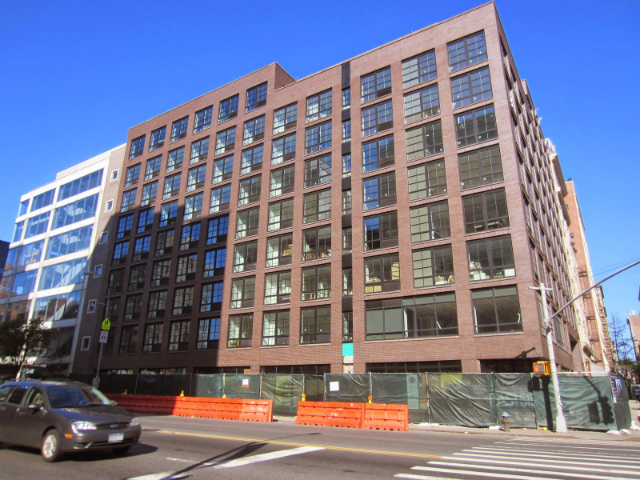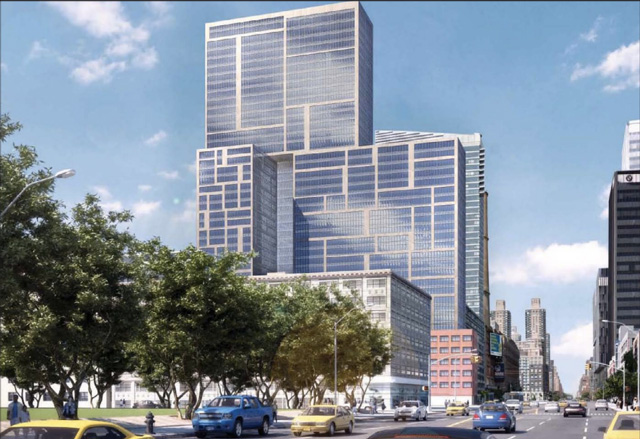New York City’s architectural legacy is in peril. The threat does not come from the 57th Street towers, nor the destruction of historic buildings, but something most would consider mundane: air conditioning.
Money can buy you a lot of things in New York, but a new rental building with central air is not among them. Unique among North America’s cities, builders in New York have forsaken generations-old technology used in every city from Los Angeles to Toronto, in favor of the lowly packaged terminal air conditioning (or PTAC) unit.
Punched through the wall below a building’s windows, PTAC units mar the façades of new rental buildings from the Financial District to Flushing, Boerum Hill to the Bronx. They are found in affordable housing developments and low-end rentals, as well as skyscraping towers in Midtown that charge $3,500 a month for a studio apartment.
“They have terrible energy performance, terrible acoustical characteristics and terrible aesthetics,” wrote one architect from a major New York City firm that’s built projects using the units.
Why they’re used in the first place is somewhat of a mystery. Simple inertia and the high cost of development in America’s largest city, forcing builders to scrimp and save wherever they can, are the most oft-cited reasons. But there are also regulatory hurdles, from special Department of Buildings permits needed for central air, to height limits that make ducted systems more difficult.
And then there’s a contingent within the city’s insular construction industry that doesn’t even realize how unique our reliance on PTACs really is. (In reality, while they’re fairly common in urban hotels and can occasionally be found in cheap rental projects and older buildings outside of New York, they’re almost never used for new luxury projects.)
But one of the city’s largest developers is starting to buck the trend. In two of their rental buildings under development – 33 Bond Street in Downtown Brooklyn, and 606 West 57th Street on the Far West Side – TF Cornerstone will be forgoing the standard below-window units in favor of more civilized forms of air conditioning.
“We raised the question [of air conditioning] anew at the 57th Street project,” TF Cornerstone’s director of planning, Jon McMillan, told YIMBY.
On 57th Street, he said, “we thought it would be nice from the interior to have floor-to-ceiling glass” – something that isn’t possible with a PTAC unit, which sits on the floor and takes up a significant amount of space. “We made the decision from the leasing point-of-view that it would make the unit seem more impressive and expansive.”
The second consideration that led to the decision to nix the PTACs, he said, was the city’s energy code.
“The PTAC unit is kind of a shoddy thing, because it’s a bunch of perforations in the façade. It’s not very efficient,” McMillan explained, “and it’s now increasingly hard to meet the energy code using PTACs.”

Karl Fischer’s clean lines at the Nathaniel in the East Village are interrupted by PTAC units in the window corners, via EV Grieve
Finally, he said, the heat pump alternative to PTACs doesn’t count towards a building’s allowed square footage, since mechanical space is deducted from a building’s floor area for zoning purposes. A heat pump sits on the floor in a corner space, feeding cool air into both the living and bedrooms, whereas a PTAC must cantilever over the floor in every room with climate control and therefore cannot be deducted as mechanical space.
PTACs, McMillan said, “are almost as hideous from the inside” as they are on the outside. “They’re really fat and bulky, and they protrude. I kept saying, why can’t anybody improve on this design? The answer I got was that we only use them in New York, therefore the market is so small that nobody bothers to try to improve them.”
TF Cornerstone’s willingness to take another look at old ways of doing business is refreshing, and other developers will hopefully follow suit. But the city should also look for ways to encourage the use of more attractive, efficient and comfortable air conditioning systems.
The stick of the energy code is one way, but the Department of Buildings should also dangle the carrot of easier compliance with permitting rules for systems other than PTACs and through-wall units. One expediter we spoke to pegged the cost of getting a so-called “equipment use permit,” needed to install central air-scale condensers (but not PTACs), at $7,000 or $8,000. The permit then needs to be renewed annually, something he said rarely happens, with heavy fines levied on those who don’t comply. Another architect told YIMBY that the city’s noise regulations effectively forbid the use of mini-splits – a ductless system somewhere between PTACs and central air, commonly used in Europe and Asia, in which the condenser can be placed on the roof or otherwise out of sight.
Rental buildings will always have cheaper finishes and fewer amenities than condos, but skimping on quality air conditioning should not be necessary. If every other city in North America has managed to find a way to deliver rentals without PTACs – often at a fraction of our rents – New York City can too.
Talk about this topic on the YIMBY Forums
For any questions, comments, or feedback, email [email protected]
Subscribe to YIMBY’s daily e-mail
Follow YIMBYgram for real-time photo updates
Like YIMBY on Facebook
Follow YIMBY’s Twitter for the latest in YIMBYnews







As an HVAC contractor I agree with your article on the death of the PTAC units. They are a nightmare to sell and maintain for our customers. The 2 main distributors in NYC are horrible to deal with especially when parts are needed they either stop making it or not in stock. Go central air!!
Central air = $26 PSF
PTAC = $5 PSF
Sure let’s require every rental to have Central Air! Smack them with the Stick of the Building Code!
If rents go up by another $1.70 PSF per year, aka $115 per month for a 800SF 2 bedroom apt, who cares!
Who are we smacking with this stick if not the poor renters in this city!!!!
Every “feel good” idea that dribbles out of the mouths of people looking to “help the masses” is done without any true thought to the people paying for this idiocy. Stop helping me, I don’t need it!
Please don’t help me with the following:
Parking requirements
Bike rooms
ADA units
High OITC windows
Endless bureaucracy
Expensive “special inspections” (what does the DOB do if not inspect?)
Mandatory umbrella insurance limits
Prevailing wage requirements
Strict Workman’s compensation laws that allow 3rd party lawsuits
Landmarking
No thank you, I can’t afford to live here as is.